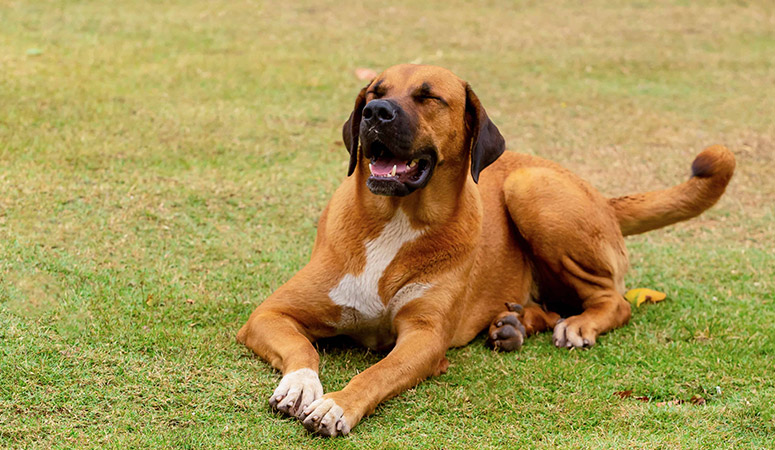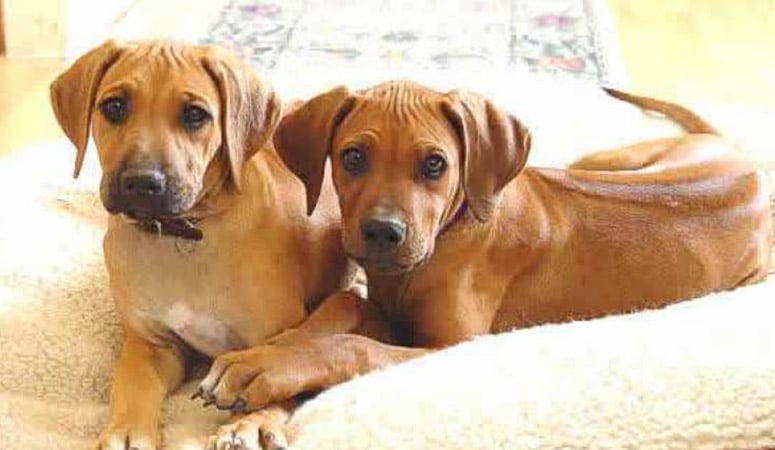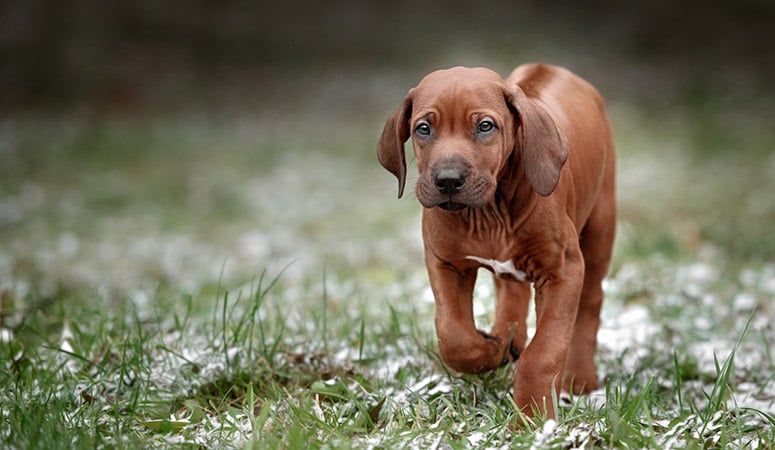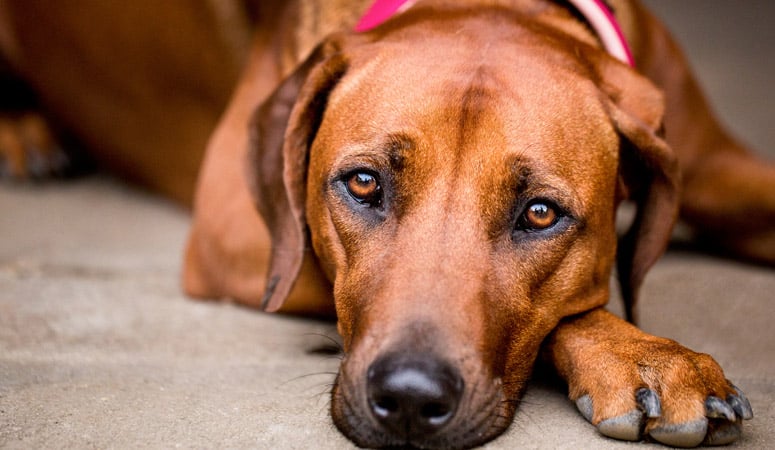Rhodesian Ridgeback
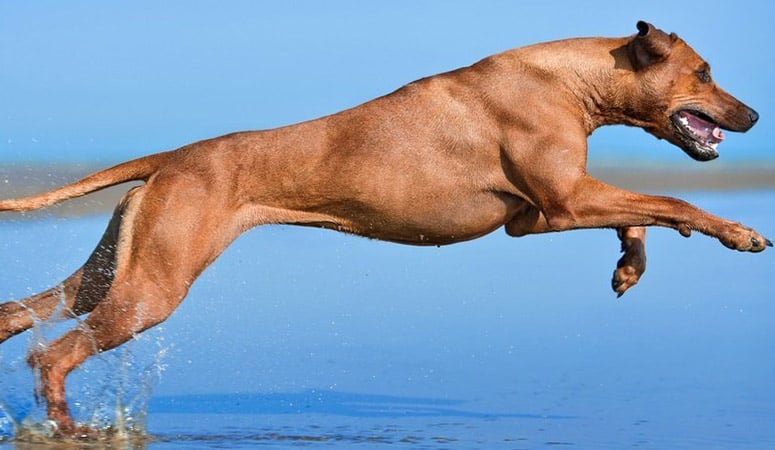
The Rhodesian Ridgebacks are powerful and fast athletes. As hound breed from Africa, Ridgebacks have strong drive to prey and excel in baying and tracking. They must be guarded and trained from the puppyhood, which will make them faithful friends of people and protective the ones they love and trust.
| Other Names | African Lion Dog, African Lion Hound |
| Color | Light Wheaten, Red Wheaten, Wheaten |
| Height | Males: 25-27 inches. Females: 24-26 inches. |
| Weight | Males: 75-85 pounds. Females: 65-75 pounds. |
| Life Span | 10~12 years |
| Personality | Affectionate, Dignified, Even-Tempered |
| Exercise | Regular Exercise |
| Origin |
| Popularity | #42 |
| Groom Needs | Weekly Brushing |
| Kids Friendly | Yes |
| Dog Friendly | Yes with supervision |
| Watch Dog | |
| Family Dog | Yes |
| Litter Size | 8.9 pups |
Rhodesian Ridgeback Pictures
Rhodesian Ridgeback Video
Introduction
This tough dog is a natural-born hunter. The Rhodesian ridgeback is a Southern African dog, a product of a few breeds; the native ridged Khoikhoi dog and dogs brought to Africa by European settlers. These include Mastiffs, Great Danes, Bloodhounds, and Greyhounds. They are mischievous dogs with enough energy and willpower to clear a low fence or a wall. People also called them “Ridgies”. Have a look on their backs; there is a ridge of hair that runs along their spine, almost in the opposite direction to the rest of their coat of short hair. Even though it is a very distinctive feature of the Ridgeback, not all Ridgies have it. They love their food and can over-eat if you give them too much food. They are great with kids, maybe a bit too rumbustious with smaller kids – nevertheless, known to be very protective amongst its family members. The Ridgeback is quiet and gentle – he doesn’t bark much. They only really use their bark as a rumble or a growl when there is danger around. So if you do own a Ridgeback and you hear it growling, you must know it is for something serious. Keep an eye on him when out walking or at the dog parks, because it can be a bit aggressive towards strangers and other dogs in unfamiliar territory. They range in color from pale flax to deep auburn; standing around 27 inches at the shoulder and weighing in at around 70 pounds.
Living with Rhodesian Ridgeback
With shiny and short coat, the Ridgebacks who live indoors need regular shedding and the outdoors require seasonal shedding every year. The breeder should begin to groom the dog from his puppyhood to develop the habit.
The Rhodesian Ridgebacks don’t need a lot of grooming. Weekly brushing and occasional bath will help the dog remove loose hair and keep the coat glossy and clean, looking his best.
Handle his paws regularly because they are touchy about their feet. Nails trimming can help the dog’s feet in good condition and avoid getting caught in the tear and carpet or prevent some problems of walking and running.
Brush the breed’s teeth at least two or three times a week to prevent tartar buildup and bacterial infection.
Giving praise and rewards will make grooming a positive experience.
Rhodesian Ridgebacks are hound breed, so they usually require a large amount of exercise to keep strong and athletic, which will make it easier to adapt to different living situations and make them admirable indoor companions. The breed needs to exercise both in body and mentality to keep healthy and happy.
They love to run and enjoy daily outings, such as play sessions, long walks and joggings with the owner every day, but they should keep on a leash to avoid becoming aggressive and dominant when meet other animals. Running six to eight miles is easy for a healthy Ridgeback, which make him a runner’s best friend.
Also they love to take part in some canine sports like agility, tracking and other activities, which should be done in an enclosed area that can prevent the dog chasing animals or roaming.
Brisk exercise of 60 minutes every day is enough for the breed to keep from being bored.
High-quality food should be divided into 2 meals and given to the Ridgeback every day. In general the better the quality of the food, the further it will nourish your dog. Just like people, the dogs are individuals, so the amount of the food should be different with the changes of his age, size, metabolism and activity level.
Measure the food when you feed them and pay attention to the calories consumption of your dog to keep him from being overweight and in good shape.
Clean, fresh water should be available at all times.
Being known as counter surfers, Ridgebacks love their food very much. So you can consider dog-proofing your cabinets to keep the food and snacks out of the breed’s reach.
Being responsible breeders, you should learn about which food are safe to your dog and which are not. Check with your vet if there are any doubts about his diet and weight.
Rhodesian Ridgebacks are generally healthy dogs, but sometimes they may get certain health conditions just like other breeds, such as Hip dysplasia, Autoimmune disease, Eye disease, Hypothyroidism, Deafness, Dermoid sinus, Gastric dilatation volvulus (bloat), etc.
Conscientious breeders will take the breed to check with the vet and screen their dogs for disease. Regular health tests include hip evaluation, thyroid evaluation and elbow evaluation.
A health clearance means the breed has been tested for some disease, but the because clearance isn’t issued to dogs that is younger than 2 years old and some health conditions don’t occur until the dog become mature.
The breeder needs to learn about some information of symptoms what to do when these diseases occur.
Total Annual Cost: $3239
Cost is estimated for the first year and may vary depending on many factors, such as dog food, health care, leash, collar, licensing, possible fencing, crates, training and obedience classes, dog-walking, grooming, treats, toys, flea, tick, and heart-worm meds, microchips, etc.
With strong prey drive, early socialization training is necessary at Ridgebacks’ puppyhood to make sure the dog grows well as well-mannered and well-adjusted companion. Rhodesian Ridgebacks are admirable competitors in agility, advanced tricks, tracking, and lure coursing.
They like to live indoors with their family. The breed doesn’t like to be left alone, which could make them get destructive or try to escape, so you should keep the fence can’t be dug under or jumped and climbed over.
Send him out into the yard by himself for hours until he becomes destruction. The Ridgeback is often inclined to dig large holes so that he can rest in the cool and comfortable dirt. You should prepare to give him part of the yard or resign yourself to having a cratered yard that resembles the surface of the moon.
Running in a safely fenced a couple of times a week and 15- to 20-minute walks or playtimes every day are necessary.
With stamina necessary for the hunt, they may be trained for pointing and retrieving. As quiet hunters, bells or a tracking collar may be advantageous during training and in the field.
History
In 1652 when Europeans arrived at the Cape, they brought dogs with them, but the dogs didn’t cope well with the local diseases, plus there was interbreeding with the indigenous hunting dogs. This is what laid the foundation for the Rhodesian ridgeback. The dog is a special creation of Southern Africa. It has resulted from crossing the dog between the native ridged Khoikhoi dog as well as European breeds that the Dutch colonists brought with them. The infusion of native Khoi blood gave the future generations a resiliency against local pests such as the tsetse fly, as well as to outwit deadly predators.
By the 1860s, European settlers were breeding the indigenous dogs with Great Danes, Bloodhounds, Greyhounds, and Terriers, resulting in the Boer hunting dog, a relative of the modern Ridgeback.
In 1922, a meeting was convened to write the first Rhodesian ridgeback standard – big game hunting was fading in South Africa, and the Rhodesian ridgeback was on the brink of extinction.
The Rhodesian ridgeback came to the United States in the 1950s and was admitted into the American Kennel Club in 1955 as part of the Hound Group.
Helpful Information
Breed Club: RHODESIAN RIDGEBACK CLUB OF THE UNITED STATES, INC.
Breed Club Link: https://www.rrcus.org/
Breed Club Rescue: Rhodesian Ridgeback Rescue, Inc.
Breed Club Rescue Link: https://www.ridgebackrescue.org/

